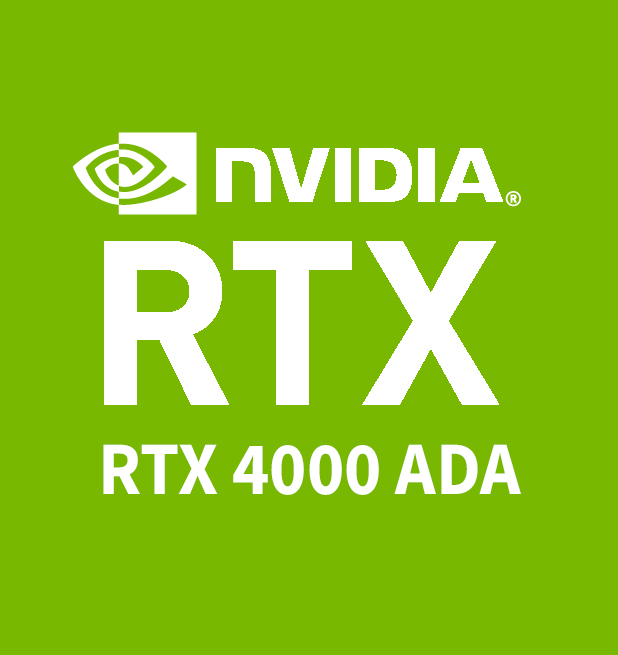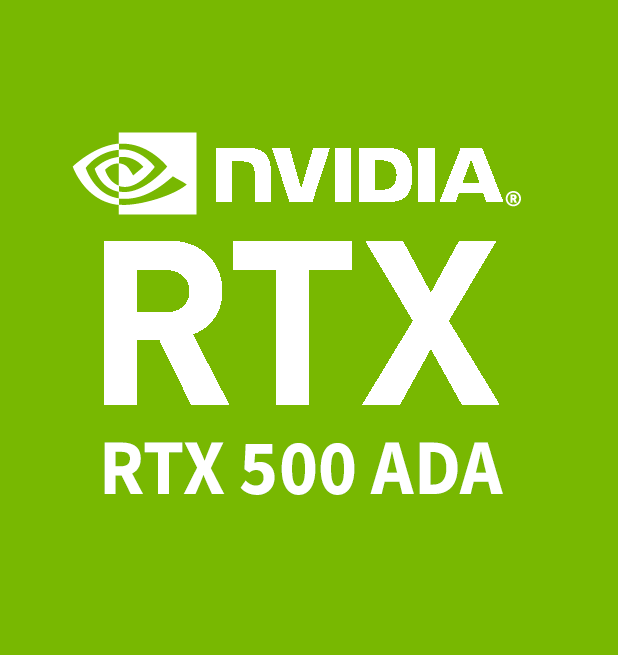Gadgetviza » Graphics Processor Comparisons » NVIDIA RTX 4000 Ada Generation -vs- NVIDIA RTX 500 Ada Generation
NVIDIA RTX 4000 Ada Generation -vs- NVIDIA RTX 500 Ada Generation
Related GPUs
Compare Related GPU
Specs Comparison Between NVIDIA RTX 4000 Ada Generation and NVIDIA RTX 500 Ada Generation
Graphics Processor | ||
|---|---|---|
Image |  |  |
Name | NVIDIA RTX 4000 Ada Generation | NVIDIA RTX 500 Ada Generation |
Architecture?The underlying design and structure of the GPU, defining its features and performance characteristics. Architectures often have specific names (e.g., Ampere, RDNA 3). | Ada Lovelace | Ada Lovelace |
Processor Size?The manufacturing process used to create the GPU, measured in nanometers (nm). Smaller processes typically result in more efficient and powerful GPUs. | 5 nm | 5 nm |
Transistors?The number of transistors within the GPU. More transistors generally indicate higher performance and more complex features. | 35,800 million | 18,900 million |
Die Size?The physical size of the GPU chip, measured in square millimeters (mm²). Die size can influence the GPU's performance and power consumption. | 294 mm² | 159 mm² |
GPU Type?The specific model of the GPU, including platform-specific variants. For example, 'RTX 4070' can refer to both desktop and mobile versions, each with different performance characteristics. | Laptop | Laptop |
TGP?Total Graphics Power (TGP) is the maximum amount of power the graphics card is designed to consume, including the GPU and its memory. It indicates the card's overall power consumption and heat generation. | 60 - 175 W | 35 - 60 W |
Launch Date | 08/2023 | 02/2024 |
Clock Speed | ||
|---|---|---|
Base Clock?The standard operating speed of the GPU, measured in megahertz (MHz). It indicates the GPU's baseline performance level. | 1500MHz | 1485MHz |
Boost Clock?The maximum speed the GPU can reach under heavy load, measured in megahertz (MHz). It represents the GPU's peak performance capability. | 2175 MHz | 2025 MHz |
Render Config | ||
|---|---|---|
Shading Units?The number of processing units within the GPU responsible for rendering graphics. More shading units generally result in better graphics performance. | 7424 | 2048 |
TMUs?Texture Mapping Units (TMUs) are processing units within the GPU that apply textures to 3D surfaces. More TMUs improve the realism and detail of rendered graphics. | 192 | 64 |
ROPs?Render Output Units (ROPs) are processing units within the GPU that handle the final stage of rendering, converting pixel data into an image. More ROPs improve the frame rate and image quality. | 80 | 32 |
RT Cores?Ray Tracing cores are specialized processing units within the GPU that accelerate ray tracing, a technique for creating realistic lighting and reflections. | 48 | 16 |
L1 Cache?The smallest and fastest cache memory level within the GPU, located closest to the processing units. It stores frequently accessed data for rapid retrieval. | 128 KB(per SM) | 128 KB(per SM) |
L2 Cache?A mid-level cache memory within the GPU that provides a larger storage capacity than L1 cache. It stores data that is less frequently accessed than L1 but more frequently than the GPU's main memory. | 48 MB | 12 MB |
Memory | ||
|---|---|---|
Memory Size?The amount of dedicated memory available to the GPU, measured in gigabytes (GB). More memory allows the GPU to handle larger and more complex graphics data. | 12 GB | 4 GB |
Memory Type?The type of memory used by the GPU, such as GDDR6 or GDDR6X. Newer memory types offer faster speeds and higher bandwidth, improving graphics performance. | GDDR6 | GDDR6 |
Memory Bus?The width of the data path between the GPU and its memory, measured in bits. A wider memory bus allows for faster data transfer. | 192 bit | 64 bit |
Bandwidth?The maximum rate at which data can be transferred between the GPU and its memory, measured in gigabytes per second (GB/s). Higher bandwidth improves graphics performance. | 432 GB/s | 128 GB/s |
Memory Clock Speed?The speed at which the GPU's memory operates, measured in megahertz (MHz). Higher clock speeds result in faster memory access. | 2250 MHz | 2000 MHz |
Perfomance | ||
|---|---|---|
Half Precison (FP16) | 26.73 TFLOPS(1:1) | 8.294 TFLOPS(1:1) |
Single Precison (FP32) | 26.73 TFLOPS(1:1) | 8.294 TFLOPS(1:1) |
Double Precison (FP64) | 417.6 GFLOPS(1:64) | 129.6 GFLOPS(1:64) |
Features | ||
|---|---|---|
DirectX?A set of Microsoft APIs that provide a standard interface for graphics and multimedia applications. Different versions of DirectX offer varying levels of features and performance. | 12.2 | 12.2 |
OpenCL?Open Computing Language (OpenCL) is a framework for writing programs that execute across heterogeneous platforms, including GPUs. It enables parallel computing for various applications. | 3 | 3 |
OpenGL?Open Graphics Library (OpenGL) is a cross-language, cross-platform API for rendering 2D and 3D vector graphics. It's widely used in graphics applications and games. | 4.6 | 4.6 |
Shader Model?A set of instructions and capabilities that define the features and performance of the GPU's programmable shaders. Higher shader model versions offer more advanced graphics effects. | 6.8 | 6.8 |
Vulkan?A low-overhead, cross-platform API for 3D graphics and computing. It offers improved performance and control compared to older APIs like OpenGL. | 1.3 | 1.3 |
Extra Technology | NVIDIA MAX-Q Technology, NVENC / NVDEC | NVIDIA MAX-Q Technology, NVENC / NVDEC |
Links | 417.6 GFLOPS(1:64) | 129.6 GFLOPS(1:64) |
Features | NVIDIA | NVIDIA |
Updated:




















